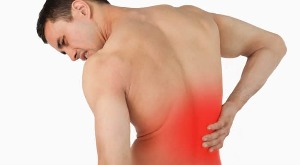
Back pain, according to statistics, about 80% of people of different ages experience this unpleasant and frightening symptom at least once in their lives. At the same time, it is important to be able to distinguish between situations in which painful sensations should disturb and when you should not worry.
Of course, if the onset of pain was preceded by exercise or a light blow, they will dissipate within 2-3 days, no cause for concern. But if your back hurts badly, for a long time and the pain is not similar to muscle pain, hurry to see a doctor.
Why my back hurts
The causes of back pain are different, from minor external factors to the development of any pathological processes, which are also many.
At the same time, doctors are still identifying the 3 most common causes:
- Non-specific pain- combines a number of factors, including muscle pain caused by improper posture, prolonged stay in one position (uncomfortable), overexertion due to excessive physical exertion of the spine and back. . . This point can also include painful sensations that occur after hypothermia, in such cases it is called - "cold back".
- Irradiation pain- occurs slightly less frequently, but cannot be ruled out. This includes diseases of the internal organs located in other parts of the body. For example, the formation of tumors and pulmonary tuberculosis, diseases of the gastrointestinal tract, heart and others. In each of these cases, the pain can radiate (give) to the back in different parts of it.
- Mechanical injuries and pathologies of the spine- pain in the spine also occurs due to a huge number of factors, we are talking about pathological processes. These include all diseases of the spine, starting with injuries (bruises, fractures, etc. ) and ending with osteochondrosis, radiculitis, hernia formation and other pathologies of the spinal region affecting the spine.
These are the main causes of back pain, summarized. All these problems threaten serious dysfunction of the spine and require a visit to the doctor.
In some cases, without adequate treatment, there is a risk of developing serious problems that threaten severe complications. If the tissues of the spine or spinal cord are affected, there is a risk of paralysis of the limbs or even the whole body.
Symptoms
In order to consult a doctor in a timely manner and to describe his complaints correctly, you need to have an idea of the symptoms.
At the same time, the symptoms of back pain may differ slightly, and if we take into account the fact that the pain itself is a symptom, its main manifestations should be emphasized, which differ in nature and location:
- By nature, painful sensations are: sharp, dull, stabbing, cutting, pain, pulling, burning, etc.
- Painful sensations are strong, moderate and weak, these indicators are individual to each person. However, they must be taken into account, for example, when prescribing treatments for chronic back pain.
- Back pain all over the spine is quite rare. More often the painful sensations are either punctate or are assigned to a separate section of the spine (cervical, thoracic, lumbar).
- It also happens that the pain in the upper spine (or any other) radiates. In this case, the pain syndrome affects other parts of the back, often called wandering.
- As a rule, acute pain in the spine is the most uncomfortable and affects everyday life, but it is often wavy and easier to treat. At the same time, dull pain is less intense, but it is constantly present, is fixed for a longer period and responds worse to therapy.
These are general guidelines for painful sensations in various areas of the back. But in addition to understanding the general symptoms of pain, it is also important to know that the clinical picture may change depending on the disease. So in one case the pain is felt between the vertebrae of the cervical spine, in another case it is localized in the lumbar region and has a different nature.
For this reason, it is worth considering separately the symptoms of various pathological processes accompanied by back pain.
Osteochondrosis
If your back hurts in the spine, the most likely diagnosis will be osteochondrosis, as this disease is more common than others. It is also important to understand that doctors distinguish three types of osteochondrosis: cervical, thoracic and lumbar.
In each of these cases, the pain between the vertebrae is related to different parts of the spine. The disease itself involves the destruction of cartilage tissue in the intervertebral discs, while the pathological process takes place in the vertebrae, as due to the reduction of the difference between them they are erased.
The main symptom of the disease is pain, but there may be clinical signs of the nervous system, as the spinal cord is most likely affected, its roots are damaged.
Myositis
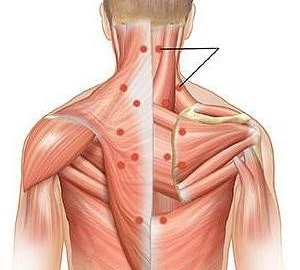
A rare disease characterized by an inflammatory process in the muscle tissues of the body, including the back. More often, myositis is accompanied by pain, but acute pain or so-called back pain is also possible.
The pain syndrome is localized directly to the place where the muscle tissue is inflamed, but the pain can radiate to nearby areas.
Spondylosis
If the spine hurts, spondylosis may be one of the possible causes. This pathology is characterized by the growth of bone tissue of the vertebrae, as well as their dystrophic changes. In this case, painful sensations occur during exercise due to a long stay in one position, for example during sedentary work.
Sciatica
The term means an entrapment of the sciatic nerve with its further inflammation. The pathological process is accompanied by cutting, stabbing, sharp pain. With sciatica, the pain is not felt constantly, it occurs suddenly, rolling in waves.
Severe sciatica pain directly at the site where the disorder or inflammation occurred. However, due to the fact that the sciatic nerve has a very large length, painful sensations are present in different areas, most often the legs hurt.
Osteoporosis
The disease develops due to a lack of calcium in the body. As a result, the bone tissues throughout the spine lose elasticity and rigidity, microtraumas and cracks are formed everywhere.
In this pathological process, the entire spine hurts, especially in the later stages of the disease.
Disc herniation
Acute and severe back pain may be evidence of a herniated disc. At the same time, the pain syndrome is constant, but increases with exercise, bending, coughing, sudden or careless movements.
In most cases, a hernia forms in the lumbar spine, which is explained by the vulnerability of this area to excessive loads, lifting weights. Hernia often occurs as a complication of osteochondrosis, which is due to the peculiarities of the course of this pathology.
In this case, the hernia is dangerous not only from pain, there is a risk of pinching the nerve branches of the spinal cord and the development of neurological symptoms.
Excessive mobility of the spine
This problem is otherwise called vertebral hypermobility or spinal instability. A clear sign of pathology are the painful sensations, which are intensified by intense physical activity and weight lifting. The painful sensations in the back are intermittent, they either subside and then suddenly reappear.
The most affected is the cervical spine, if the disease progresses, it becomes difficult for a person to hold his head.
Scoliosis
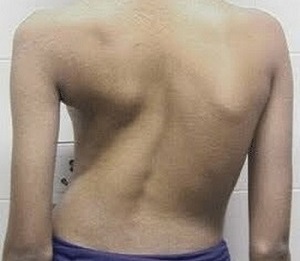
Oddly enough, a curvature of the spine is a direct cause of pain. One of the most common problems is scoliosis. The pain of scoliosis is more muscular in nature. This is due to increased stress on certain back muscles while others are relaxed.
In scoliosis, due to the curvature of the spine, individual spinal discs are compressed and the cartilage tissue is deformed.
The painful sensations in scoliosis are constant, painful or pulling, their intensity is low, in rare cases the pain is strong and sharp.
Spinal cord injury
Of course, any mechanical damage, even minor, is painful. In this case, the pain is stronger the more severe the lesions, and sometimes even with a seemingly minor injury, sharp pain is felt, which may indicate severe internal injuries. In this case, blows, bruises, sprains, sprains are taken into account, but fractures are the most severe type of injury.
It is noteworthy that old, long-healed injuries are felt decades later. So back and neck pain can remind you of how you fell on the ice as a child.
Bechterew's disease
This dangerous disease is also called ankylosing spondylitis. The pathology is characterized by a chronic inflammatory process in the joints, in other words, inflammation of the spine.
Ankylosing spondylitis is accompanied by severe pain and the intensity of the pain syndrome is high from the very beginning of the pathological process and intensifies only in the future. In this case, the pain intensifies after rest and depending on the change of time, but they are well controlled by drugs from the group of NSAIDs and physiotherapy.
Cancer
Cancer is the most dangerous pathology, the clear sign of which is pain. In this case, the pain syndrome occurs in both benign and malignant neoplasms, if they are located not far from the spine and put pressure on it.
Metastases are an even more dangerous manifestation of oncology. In this case, the pain is constant and strong, they haunt a person always and everywhere, regardless of body position or any action. Your back hurts just as much even when you are lying down.
Kidney disease
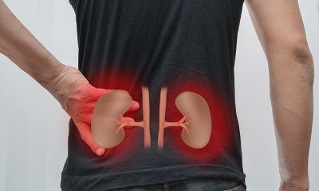
The causes of low back pain are not always related to back problems. Due to the anatomical location of the kidneys, the pathologies that affect them also respond to severe pain in the lumbar region.
The pain can be dull and pulling or sharply stabbing, their intensity varies depending on the disease and the degree of its progression.
Here it is important to understand that the painful sensations can be on both sides or only on one side, which indicates which kidney is involved in the pathological process.
Cardiovascular pathology
It is wrong to think that in diseases of the cardiovascular system the pain occurs exclusively in the chest. For example, in ischemic heart disease and myocardial infarction, painful sensations are transmitted radiating from the back to the chest area. They are characterized as sharp, piercing and appear suddenly.
Pathologies of the cardiovascular system include aortic aneurysms, in which there is a sharp sharp pain near the spine in the chest area.
Pathology of the digestive tract
Digestive tract diseases also often provoke back pain, but in such cases there are always a number of distinctive clinical signs. In addition to pain, there is indigestion, nausea, vomiting, diarrhea or diarrhea, and general malaise.
Infections
Among the infectious diseases accompanied by back pain, the most severe and dangerous is bone tuberculosis. The disease is accompanied by severe pathological processes in the bone tissues, hurts the entire spine. The pains have a different character, sometimes pulling, sometimes piercing, but they are always constant.
Respiratory diseases
The lungs occupy most of the chest area, which is why lung pathologies are often accompanied by back pain. Such diseases include pneumonia, pulmonary tuberculosis, pleurisy, etc.
In such pathologies, the pain intensifies during coughing, sneezing, deep breathing, yawning. In addition, the clinical picture is enriched by cough, shortness of breath and other similar symptoms.
Congenital pathologies
The factor of congenital anomalies is extremely rare, but still occurs. In this case, the main suspicion falls on the congenital excess or insufficient number of vertebrae in the spine. This affects the muscles and ligaments, the structure of the body, threatens the protrusion of the spine or compression, which is invariably accompanied by pain.
Pregnancy and childbirth
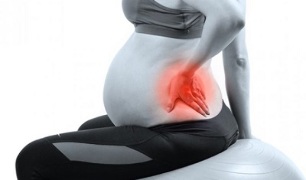
Pregnancy is also one of the causes of painful back symptoms.
Spinal pain and other problems of a similar nature occur more often by the third trimester, which depends entirely on the growth of the fetus and the increased load on the spine.
In such cases, the pain is usually dull, pulling, it subsides or temporarily disappears after a short break when the expectant mother goes to bed.
Inflammatory processes
Many different inflammatory processes lead to the development of pain syndrome, some of which we have already talked about. Take spondyloarthritis (ankylosing spondylitis). This pathology begins in the lumbosacral region, then inflammation and with it back pain rises up the spine.
Pain radiating to the spine
As mentioned at the beginning, there is a class of pain called radiation. This means that back pain "gives" to the spine from other parts or organs in which the disease has flared up. Let's talk about such pain in more detail.
Pathologies of the heart and large vessels
The most likely diseases of the cardiovascular system, accompanied by back pain, were mentioned earlier. It is only important to understand that in addition to pain, such pathologies are accompanied by disorders of blood pressure, arrhythmia and pale skin, this is their distinguishing feature.
Gallbladder diseases
The most striking example of such a pathological process is cholecystitis, which leads to radiation pain in the right shoulder blade and the central part of the spine in the thoracic region.
The acute form of the disease is accompanied by severe cuts, while the chronic one is more difficult to diagnose because the pain is intermittent and of low intensity.
Lesions of the pancreas
The most common disease of the pancreas is pancreatitis. The clinical sign of such a condition is abdominal pain, but they are also surrounding, characterized as sharp, piercing. However, in addition to pain, the patient suffers from nausea, vomiting and painful sensations appear after eating fatty, sweet, fried foods.
Pathology of the kidneys and upper urinary tract
Kidney and urinary tract diseases are also accompanied by pain syndrome and it is usually intense. Severe pain occurs during urolithiasis, but it is felt not only in the lumbar region. There is severe discomfort in the lower abdomen and groin.
Diagnostics
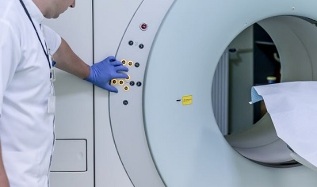
As can be seen from the huge list of possible problems and possible diseases, in order to eliminate the pain in the back and spine, it is necessary to identify the main root cause of its occurrence.
To do this, you must consult a doctor and make a full differential diagnosis, which includes:
- Radiographyis a simple but quite effective way to determine the condition of the spine, allowing to detect deformities and various pathologies.
- CT- computed tomography more accurately reveals the pathology of the intervertebral discs and vertebrae.
- MRI- magnetic resonance imaging is an even more advanced and most effective diagnostic method that will not only show possible problems in the structure of the vertebrae and intervertebral discs, but will also allow toidentifies or excludes the involvement of nerves in the pathological process, the spinal cord.
If the above studies did not work, please contact specialists with a narrow profile in other areas. Maybe the problem lies in diseases of the heart, gastrointestinal tract, kidneys, pelvic organs, etc.
How to treat back pain
The treatment of acute back pain requires a comprehensive and systematic approach. The methods of control become clear after a complete examination and accurate diagnosis. It is also important to understand that in case of problems of this nature it is mandatory to contact a specialist, self-medication is by no means unacceptable.
The doctor will determine the treatment regimen, which will probably include drug therapy, physiotherapy, exercise and a course of massage.
Physiotherapy
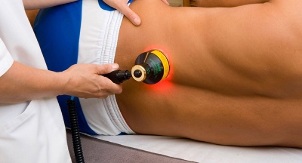
This is one of the main methods for dealing with pathologies involving the spine.
The treatment of back pain includes the following procedures:
- Electrophoresis.
- Ultrasound exposure.
- Laser therapy;
- Magnetotherapy.
The treatment is carried out within 7-10 or more procedures, the intervals between procedures are 3-5 days.
Gymnastics
Physiotherapy and gymnastics are also included in the treatment of pain syndrome, but these techniques are mainly used for recovery when there is no more severe pain. Gymnastics is necessary to restore muscle elasticity, mobility, keep them in good shape and accelerate recovery from back injuries.
It is important to conduct the first sessions with a physiotherapist, who will adjust the methodology and distribute the load, will teach you how to do it right. In the future, classes are held at home and most importantly, the requirements are a systematic approach.
Drug therapy
Drug therapy is at the heart of all treatment. Each drug is prescribed by a doctor based on the diagnostic data obtained. The technique depends on the intensity of the pain syndrome, the stage of disease progression.
The following medications are needed for back pain:
- NSAIDs(non-steroidal anti-inflammatory drugs) - prescribed in the form of ointments, tablets, injections, sometimes in the form of suppositories. NSAIDs have anti-inflammatory and analgesic effects and reduce local temperature.
- Analgesicsare painkillers that block the nerve centers responsible for recognizing pain.
- Muscle relaxantsare used when muscle spasm needs to be eliminated.
- Vitamin complexes,including B vitamins. Their effect contributes to the recovery of nerve fibers and the establishment of metabolic processes.
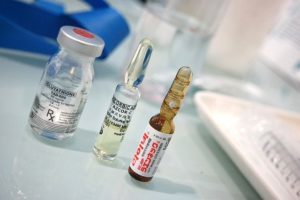
The duration of drug therapy, the frequency of drug use and the dosage are determined by the physician.
Massage
Massage is another effective method of pain relief. It is appointed when the painful sensations subside, it is performed exclusively by a narrow specialist.
Massage therapy can stimulate blood circulation, relieve pain, restore the elasticity of the nose and muscles, etc. To achieve a tangible effect, a course of massages consisting of at least 10 sessions is required.
Prevention
To minimize the risk of developing pathologies that cause back pain or reduce the risk of disease recurrence, you should follow simple preventive recommendations:
- Eliminate bad habits.
- Eat right, eat less junk food, switch to a partial feeding system.
- Lead an active lifestyle, play sports, preferably swimming or some form of gymnastics.
- It is useful to hang your back on the horizontal bar at least 3-4 times a week.
- When sitting, take breaks to warm up.
- Avoid strenuous exercise and injury.
- If it is impossible to avoid lifting weights, do everything right, lift heavy things with a straight back.
- Sleep on a moderately firm bed, buy an orthopedic mattress.
Remember that if the pain lasts more than 4-5 days or if the pain is so severe that it is difficult to bear, see your doctor immediately. Timely treatment allows you to save health and avoid many dangerous complications.



































